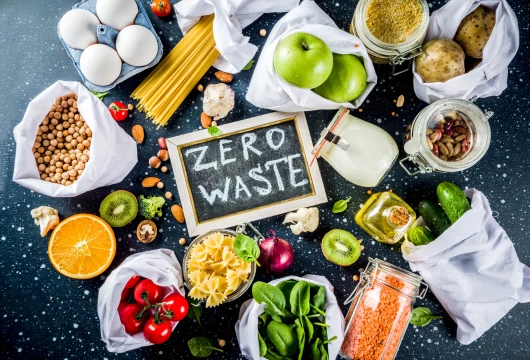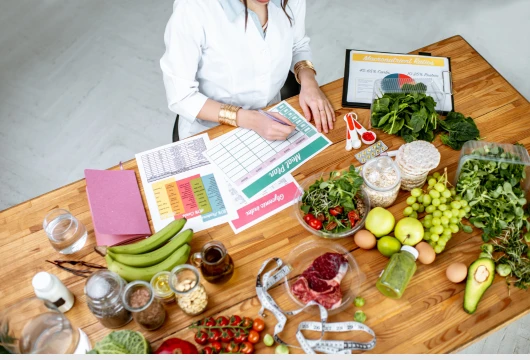Most of us think of sustainability as something that happens in policies, industries, or tech innovations. But the truth is — the biggest climate actions often begin in the smallest spaces: our kitchens.
From food waste to excessive energy use, our kitchens can unknowingly contribute significantly to our carbon footprint. Yet, with just a few smart changes, we can turn this everyday space into a hub of conscious living.
This article explores 7 practical, easy-to-implement kitchen hacks that not only reduce your environmental impact but also save money, improve efficiency, and enhance your connection with food.
1. Go Local, Go Seasonal : The Foundation of a Green Plate

Why It Matters
Food miles — the distance your ingredients travel from farm to table are a major contributor to greenhouse gas emissions. By eating local and seasonal, you reduce transportation-related emissions, support local farmers, and get fresher, nutrient-rich produce.
How to Do It
- Shop at local farmer’s markets or subscribe to community-supported agriculture (CSA) boxes.
- Use apps and local WhatsApp groups that connect you directly to nearby producers.
- Plan your weekly meals around what’s available seasonally — mangoes in summer, gourds in monsoon, greens in winter.
The Impact
Choosing locally grown food can reduce your carbon footprint by up to 7-10% annually, while also boosting rural livelihoods — a perfect mix of sustainability and equity.
2. Compost Your Kitchen Waste : Close the Food Loop
Why It Matters
According to the UNEP, around 50% of household waste in India is organic. When this waste ends up in landfills, it decomposes anaerobically, producing methane — a greenhouse gas 80 times more potent than CO₂.
How to Do It
- Start small with a DIY compost bin using an old bucket or purchase a ready-made composter.
- Segregate waste: keep a separate bin for vegetable peels, fruit scraps, and coffee grounds.
- Add dry leaves, paper, or sawdust to maintain a balance of carbon and nitrogen.
The Impact
Composting not only reduces landfill waste but also gives you nutrient-rich manure for your home garden — creating a zero-waste kitchen ecosystem.

3. Save Energy : Smart Cooking, Smarter Appliances

Why It Matters
Kitchens are one of the most energy-intensive spaces in a home. From refrigerators to microwaves, they consume substantial electricity daily. Choosing energy-efficient practices and appliances can drastically reduce your household’s carbon footprint.
How to Do It
- Opt for 5-star rated appliances certified by the Bureau of Energy Efficiency (BEE).
- Use pressure cookers and induction stoves — they cook faster and use less energy.
- Cook multiple dishes together to maximize gas or electricity usage.
- Turn off appliances completely instead of leaving them on standby mode.
The Impact
Upgrading to efficient appliances and adopting smarter cooking habits can cut your kitchen’s energy consumption by 20–30% annually.
4. Conserve Water : Every Drop Counts
Why It Matters
India is among the world’s most water-stressed countries. A sustainable kitchen is one where not a drop goes to waste.
How to Do It
- Install aerators on kitchen taps to reduce water flow.
- Rinse vegetables in a bowl instead of under running water — reuse that water for plants.
- Fix leaks promptly — a dripping tap can waste up to 20 liters per day.
- Run dishwashers only when fully loaded, or wash dishes in a two-bowl system: one for soaping, one for rinsing.
The Impact
Simple water-saving measures can reduce your kitchen water usage by up to 50 liters a day, ensuring that sustainability begins right at your sink.

5. Rethink Storage : Ditch Plastic, Embrace Durability

Why It Matters
Plastic storage containers, cling wraps, and disposable packaging are convenient but ecologically costly. Most plastics are non-recyclable and take hundreds of years to decompose, polluting soil and water.
How to Do It
- Replace plastic containers with glass jars, stainless steel boxes, or bamboo containers.
- Wrap food using cloth covers or beeswax wraps instead of cling film.
- Buy groceries in bulk to minimize packaging waste.
- Reuse glass bottles and jars creatively — as spice containers, planters, or storage organizers.
The Impact
Reducing plastic in your kitchen not only cuts waste but also minimizes microplastic contamination in your food and water — protecting both health and environment.
6. Upcycle and Reuse : Turn Waste into Wonder
Why It Matters
Sustainability isn’t just about reduction; it’s about reinvention. The kitchen offers endless opportunities to upcycle — transforming leftovers, scraps, and packaging into something valuable.
How to Do It
- Reuse citrus peels to make natural cleaners or fresheners.
- Turn stale bread into breadcrumbs or croutons.
- Regrow herbs and greens like mint, coriander, or spring onions from kitchen scraps.
- Transform old utensils into planters or decorative holders.
The Impact
Upcycling cuts down waste, saves money, and inspires creativity — proving that sustainability can be fun, not just functional.

7. Mindful Meal Planning : Cook Smart, Waste Less

Why It Matters
Globally, one-third of all food produced is wasted. In India, food waste during storage, cooking, and serving is rampant. Mindful planning ensures we cook only what we need and make the most of what we buy.
How to Do It
- Plan weekly menus and shop accordingly.
- Store perishable items properly — use your fridge efficiently by keeping airflow clear.
- Cook smaller portions, especially for perishable dishes.
- Get creative with leftovers — turn yesterday’s rice into today’s stir-fry or soup.
The Impact
Mindful cooking reduces food waste, lowers your grocery bills, and fosters gratitude for food — an essential ingredient of sustainable living.
The Bigger Picture: The Kitchen as a Climate Classroom
The kitchen is more than just a place for food; it’s a daily laboratory of sustainability. Every choice — from ingredients to energy to waste — has ripple effects on ecosystems, supply chains, and communities.
By adopting these seven sustainable kitchen hacks, individuals can play a tangible role in tackling major global issues like:
- Food waste and methane emissions
- Plastic pollution
- Water scarcity
- Excessive carbon emissions from energy use
In fact, if every urban household in India implemented even half of these hacks, the country could save:
- Over 10 billion liters of water annually
- Nearly 2 million tonnes of food waste
- Around 500,000 tonnes of CO₂ equivalent emissions
That’s the power of individual action multiplying into collective impact.
How Sustainable Kitchens Are Changing India
1. Zero-Waste Cafés and Homes
Cities like Pune, Bengaluru, and Auroville are leading with zero-waste cafés that compost, recycle, and source locally. Many urban families now run “mini circular kitchens” using home composting and plastic-free storage systems.
2. Social Media Movements
Instagram hashtags like #SustainableKitchenIndia and #ZeroWasteCooking have become communities where people share hacks, recipes, and eco-friendly swaps.
3. Policy Push
Municipalities across India are promoting home composting subsidies and ban on single-use plastics, making it easier for households to transition sustainably.
Actionable Takeaways
| Goal | Hack | Immediate Benefit |
| Reduce Waste | Compost & upcycle | Lower landfill contribution |
| Save Energy | Smart cooking | Lower electricity bills |
| Save Water | Tap aerators & reuse | Reduce water footprint |
| Cut Plastic | Reusable containers | Healthier storage |
| Support Local | Seasonal ingredients | Boost local economy |
| Waste Less Food | Mindful meal planning | Save money, eat better |
Sustainability doesn’t need to start with a grand gesture. Sometimes, it begins with how you chop vegetables, store leftovers, or plan a meal.
For more inspiring Blogs, click here

